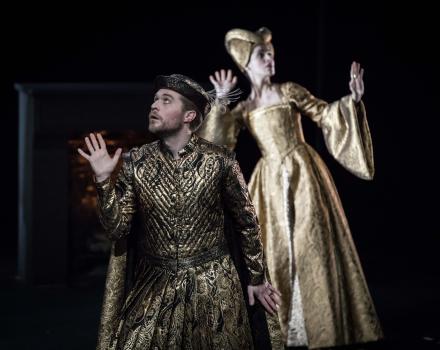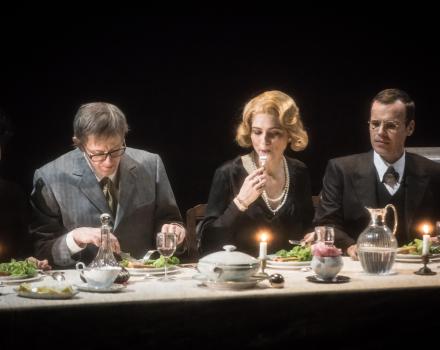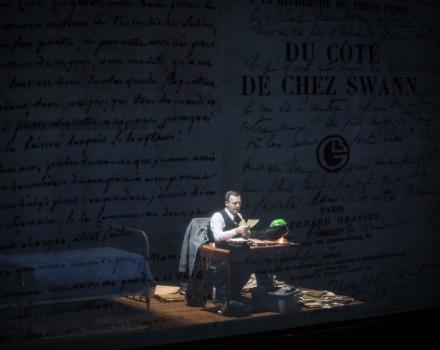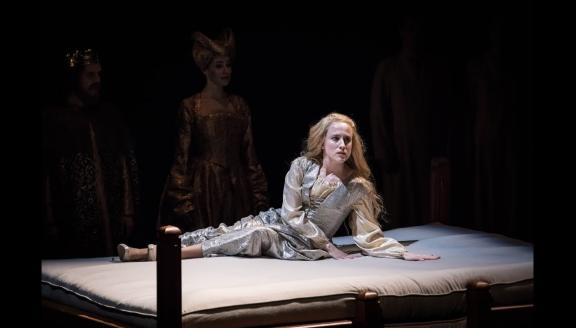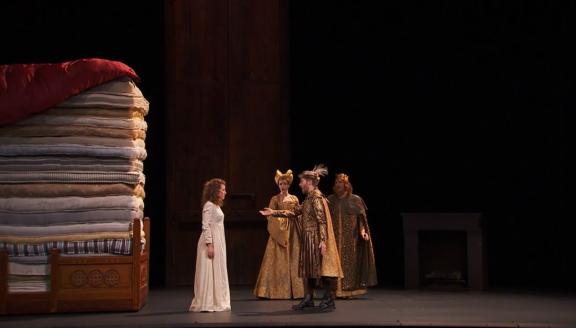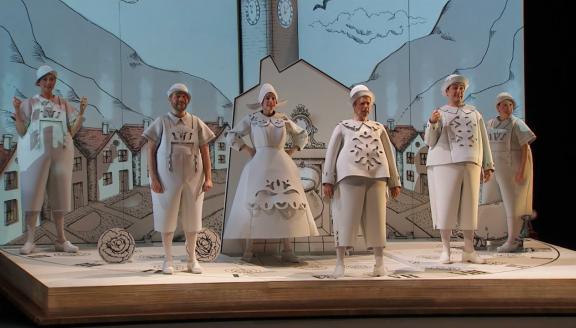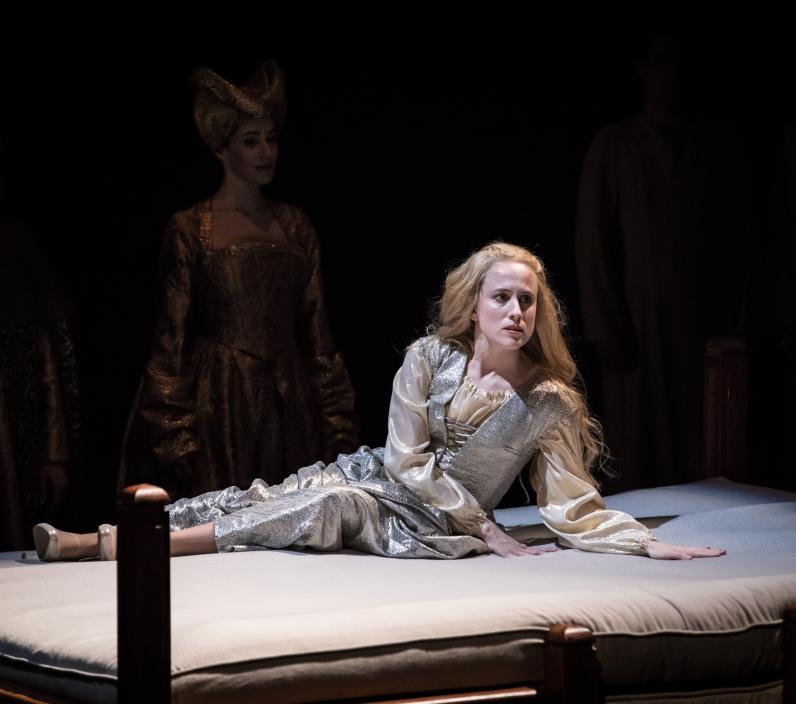

Lost among strangers, a sensitive princess, a famous writer and an unwelcome devil try to find their place in an unfamiliar world.
With his accessible and willingly facetious music, French composer Gérard Pesson has created an operatic adventure through three fairy tales. Their marvels are treated with fantasy and delicacy by librettist and director David Lescot.
Cast
|
The Queen | Guérin's secretary | Hostess
|
Camille Merckx
|
|---|---|
|
The King | Jacques Guérin | Belfry guardian
|
Marc Mauillon
|
|
The Prince | Werner | Boy
|
Enguerrand de Hys
|
|
The Princess | Visitor, Library | Boy
|
Maïlys de Villoutreys
|
|
The other Princess, Handmaid | Museum Guide, Marthe Dubois | Boy
|
Melody Louledjian
|
|
Servant | Robert Proust, Museum's curator | House Master
|
Jean-Gabriel Saint Martin
|
|
The narrator
|
Jos Houben
|
|
Dancer / Choreographer
|
Sung Im Her
|
|
Orchestra
|
Ictus Ensemble
|
| ... | |
|
Music
|
Gérard Pesson
|
|---|---|
|
Conductor
|
Georges-Elie Octors
|
|
Director
|
David Lescot
|
|
Sets
|
Alwyne de Dardel
|
|
Lighting
|
Paul Beaureilles
|
|
Costumes
|
Mariane Delayre
|
|
Text
|
David Lescot in three parts based on The Princess and the Pea by Hans Christian Andersen, Proust's Overcoat by Lorenza Foschini and The Devil in the Belfry by Edgar Allan Poe
|
|
Musical assistant and vocal coach
|
Christophe Manien
|
|
Make-up and hairstyling
|
Elisabeth Delesalle
|
|
Assistant stage director
|
Linda Blanchet
|
|
Assistant set designer
|
Claire Gringore
|
| ... | |
Video
The story
The Princess and the Pea
A prince returns from a trip around the world without having found the princess of his dreams. Shortly afterwards, a young woman caught in a storm comes to the castle gate and asks for shelter for the night. The Queen makes her sleep on a bed made up of twenty mattresses and twenty quilts, under which she has secretly placed a pea.
Proust’s Overcoat
Marcel Proust is dead and now his personal effects have disappeared: his manuscripts, his furniture and, worst of all, his famous fur coat. The item becomes a kind of ghost of the disappeared writer in this detective story full of coincidences, twists and turns, suspense and survival.
The Devil in the Belfry
For the citizens of the village of Vondervotteimittis, their daily lives are determined by the clock in the belfry. But one day their regular schedule of cooking sauerkraut, smoking a pipe and then eating the sauerkraut is disrupted by the arrival of a violin-playing devil, whose music interrupts the regular rhythm of the villagers' lives.
Insights
An Open Work
David Lescot, librettist and director of Trois Contes, explains how three stand-alone stories come together in his new opera.
Trois Contes is a chamber opera project in the form of a triptych, composed by Gérard Pesson. It is a very free adaptation of two stories - Hans Christian Andersen's The Princess and the Pea and The Devil in the Belfry by Edgar Allan Poe - and a book by Lorenza Foschini about a coat owned by the writer Marcel Proust, Proust’s Overcoat. The three stand-alone stories are distinct, but their common elements and themes echo between each other. It is an invitation to interpret what we hear and see, to build our own meaningful links between the stories. Trois Contes would therefore be what Umberto Eco called an ‘open work’, making this quality a condition of modernity.
The Princess and the Pea, a short tale by Andersen, will be here a plot with 6 repetitions and variations. Each version has a different relationship between the music and text. In the first version, the music is hypnotic, fast, almost mechanical. The second version, by contrast, is ‘more than slow’, and the story, as if exhausted, stops before the end. The third is an express version of The Princess and the Pea in one minute. The fourth takes exactly the same staging, gestures, attitudes and light as the previous one, but changes the text and music, as if the soundtrack of a film had been changed. The fifth is a ‘musical comedy’ version, composed of a series of lyrics, a sunny and happy version to the point of absurdity. Finally, the sixth and final one is a ‘dark’ version where the princess is not welcomed by the prince's family, and rejected as a foreigner.
The story of Proust's Overcoat begins in the basement of the Musée Carnavalet, where this coat, too fragile to be exhibited, is kept in a large cardboard box. Thus the museum, where the pea is placed, makes the transition between the first and second part. In this act, unlike the first, the voice is less present. The text is sometimes sung, spoken, given in text to read, to decipher. Quiet rhythm, fading, shadow effects. We can think of a picture book in which we turn the pages one by one, each making up a tableau. The objects, their fragility, their sacred status, are as much the protagonists of the story as the characters. The music is erased, mysterious, allusive, made of silhouettes and memories.
The third part, The Devil in the Belfry, is adapted from the short story by Edgar Allan Poe, who by his irony and sense of caricature prefigures the comic strip, or the cartoon. Here we have a choral group of six voices using refrains, songs and invented folklore to punctuate the story delivered a narrator, the Belgian actor Jos Houben. As in Poe's short story, the structure takes that of a conference with the narrator borrowing the taste for manic bibliographical references and etymological hypotheses from academic communications. As the speaker describes his subject, it appears and comes to life around him. But then he allows it to be destroyed from within by introducing the Devil into it.
The image, as much as the music, must show the distance, the particular and innovative irony of Poe's short story. A violinist in Poe’s short story, the appearance of the devil in this opera is transformed into a moment of choreography. The devil is a unique rhythm that contrasts with the general rhythm, and in this it is both destructive and liberating: an idea that is reflected in a dance, in contrast to the regular immobility of the villagers in the chorus. The idea of rhythm is dealt with here in a ferocious way: the rhythm of Vondervotteimittis is the litany that is constantly repeated over and over again in successive and similar days, against a backdrop of puritan satisfaction.
It is therefore up to the viewer to establish the thematic and symbolic links that link the three works, which are multiple, beyond their differences. But we can insist on the idea that the figure of the foreigner circulates between the three tales: the princess, who arrives from nowhere and must pass a test to prove what she is; the writer Marcel Proust, who is a stranger in his own family by his art and his morals; and the stranger represented as the devil, who bursts into the heart of a community mechanically riveted to its habits and who, by disrupting it, reintroduces the liberating principle of art as a life force.
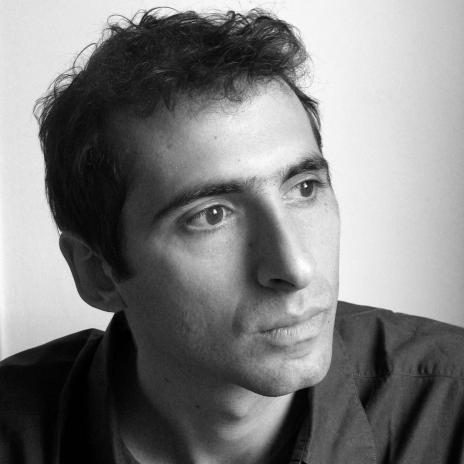
Born in 1971, David Lescot is a playwright, musician and director. His writing and stage work combine theater with music, dance and documentary material. He directed his first opera in 2011 with Stravinski’s The Rake's Progress at Opéra de Lille. He followed this up in 2012 and 2013 with Le Système de Ponzi, a choral and musical work dedicated to the excesses of finance; then Haydn’s Il Mondo Della Luna at the MC93 in Bobigny; and in 2014 with Mozart's La Finta Giardiniera back at Opéra de Lille with Emmanuelle Haïm at the podium.
Gallery
